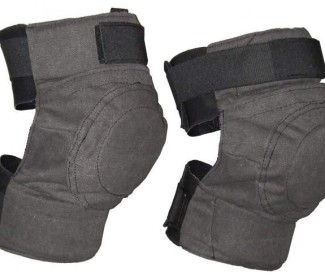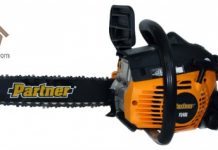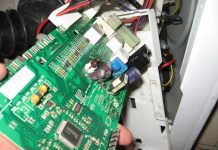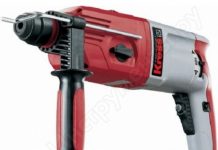Observing further on Sal DiBlasi as he uses the new knee pads, an input can be made - NO WAY.
VIDEO
The best way to understand why the new device did not fit (you cannot call it otherwise) is to ask Sal DiBlasi. But you can take a chance and do it for him:
Habit is second nature. It takes time to win and develop a new one. But if the new knee pads were more comfortable, then the germination of a new habit would go faster.
"Adaptation" - this is the main drawback. Everything is very complicated and cumbersome.But this does not mean that they are hopelessly bad. If you simplify them by taking the best practices, you can get a good result.
When carrying out construction work, plumbing, electricians, tilers, etc. spend some time kneeling tiling / laying cables / pipes. Anyone who has tried to kneel on concrete chips and concrete floors knows what it is and inevitably uses knee pads. At the masters I saw only these, mainly from chain building stores:
The first option is attached with Velcro, which makes these knee pads just a test, because:
-They squeeze the leg and prevent it from moving on the leg when getting up and down on the knees
-Start rubbing after 15 minutes of wearing
-The Velcro comes off and the knee pads only go to the trash heap.
The second option is the same as the first, only it is kept on one rubber tie.
It's time to pick up a new robe and then I found out one curious thing. Mid-range robes and above have a knee pocket that opens either from the bottom or from the top. I have seen this pocket many times, including on my formal dress rehau, which they donated, but it never even crossed my mind that this pocket was used for knee pads!
I realized this when I read the description for the new robe, which I chose on the site. This scheme works as follows. We have:
Such inserts, the cost is 100-200 rubles, are sold in all clothing stores.
Robe with knee pockets where these inserts are inserted.
Thus, we get knee protection that does not interfere or cause discomfort.
It is cheaper than any other type of knee pads and has a long service life.
However, there is a small nuance when choosing clothes with such knee pads:
Pockets come with a flap on the top and bottom, take those that have a flap on the bottom, since when chipping under the wiring (like mine for example), stones will fly into them, and it is impossible to pour it out until you take off your pants.
At work, I often have to lean on my knee (or) and without proper protection, let's say, the sensations are rather unpleasant and irritable. Cold, sometimes uneven genital surfaces do not have a very beneficial effect on the condition of the knee joint. How to be? Well, of course the knee pad (s) ...
There is a huge selection of this product on sale, its variety is amazing, the price range is also wide. Models for gardeners, builders (finishers), airsoft players, melitarists ... a choice for every taste and color.
But why not try to make this, rather simple and at the same time, complex element of protection yourself ... why so ?! Because for a gardener it is enough to make bottles from penofol or PET, but for a stormtrooper. already a completely different story ...
So I offer my (working) version, tested and verified. The kneecap (s) are made of sheet rubber (there was an idea to make cars out of a tire, a very interesting option for BP, when knee protection, I think, will be very relevant).
The form was not born spontaneously, but deliberately, taking into account the anatomy of the knee joint, ease of wear and use. I agree if someone says that this option is rather clumsy, but I repeat ... it satisfies all my requirements for exploitation and simplicity ... Over time, maybe I will improve this design (well, put spikes there and protective plates ..
A small request, if anyone has constructive suggestions or already has real (practical) developments, then put them up for general discussion ... because there is no limit to human imagination.
Well, actually, the culprit himself ...
The production time for 1 copy is about five minutes ...
The following tool was used for manufacturing ...
but I think that in case of BP or emergency, one knife will be enough ...
A pattern with dimensions in cm is given for clarity, but everything is done by eye and by sensations ...
Several images ... how it sits (looks).
P.S. For commercial use, the link and% are required.
Plastic bottles; glue "Moment"; soft cloth; awl; big pin or big tailor; wide elastic bands.
First, prepare the main element of the original garden - bottles. A container with a volume of 1.5 or 2 liters is suitable. They should have lids. The number of bottles depends only on your preference and the length of the vertical surface. They should be rinsed first if you intend to use bottles other than water, but beer or sugary drinks. Their remains can provoke the appearance of mold in the soil.
Cut a rectangular hole in the side of each bottle. Don't make it too small, or it will be uncomfortable for you to plant a plant in it.
Equip yourself with an awl and use it to punch through holes on the bottle for the rope. To do this, lay the container on its side so that the cut out rectangular hole is on top. Two rope holes should be located next to this hole, one on each side. Two more holes must be made strictly under the upper holes. For convenience, the awl can be preheated.
Make a drain at the bottom of the bottle to drain excess water. Plants usually do not need stagnant water.
Thread the ropes through the holes you made and tie knots under each on both sides. They will not let the bottles slide. On one rope, if desired, you can string several bottles at once.
Hang ready-made structures from the fence or wall of the house. It is better to do this in a checkerboard pattern.Now you can fill bottles with soil and plant seedlings of vegetables in them.
For such a bottle garden, parsley, green onions, lettuce, coriander, dill are ideal. Even radishes can be grown in bottles if desired.
Believe me, a galaxy of bottles with plants on the wall of a house or a fence is not only practical, but also very original. The bottle garden will spice up the décor of your site.
today I share very comfortable knee pads (in my opinion)
Previously, I had many options, but they all crawled under the trousers or bulged up in a lump.
and these came and did not let me down
knitted from yarn 25% -dog wool
ribbed part, I called it an accordion, knits 3 rows with front loops, 3 rows with purl
Knit from above with an elastic band 1x1 = 10 cm in a circle
my husband is fishing, I knit (photo in field conditions
then we move on to knitting an accordion in my version it is 12 loops
put a marker 12 faces, a marker, turn 12 lives, turn 12 faces, continue knitting in a circle
with a 1x1 elastic band on both sides of the marker, make an offset by one loop in each strip
(BUT THE TOTAL NUMBER of loops does not change)
marker 14 out, marker, turn, 14 faces, turn, 14 out, continue knitting in a circle
marker 16 faces, the marker is rotated, 16 out, rotate, 16 faces continue in a circle 1x1
so I got 34 loops (wide part of the accordion)
then we knit another 4 cm without displacement, as much as possible, this is at your discretion
Now we knit an accordion, but for a narrowing
marker 34 persons, marker, turn 34 from, turn, 34 persons, 1x1 elastic in a circle
marker 32 from, marker, turn, 32 faces, turn 32 from, elastic band 1x1 in a circle
marker 30 faces, marker, turn, 30 out, turn, 30 faces, 1x1 elastic band in a circle
and so on until there are 12 loops (accordions)
now just go to 1x1 elastic and knit another 3cm and start
make a reduction in the loops (due to them, the knee pad does NOT slide)
knit 7 loops with an elastic band and knit 3 loops together (we try not to break the loops of the elastic (you can see in the photo)
at the top of the knee pad the elastic is longer, and at the bottom it is shorter
Now we knit with an elastic band 1x1 another 4cm, all the knee pad is ready!
and knees will thank you
MANY THANKS I didn’t think that knee pads would produce such a flurry of kind words.
Knee pads produced by fishing companies are usually thin, and it is inconvenient to catch from knees for a long time. In addition, when fishing in wet snow, as well as in the presence of water on the ice, it is impossible to stand in thin knee pads, as the overalls get wet. That is why, more and more often, anglers use thicker izolon knee pads.
To make such knee pads on your own, you will need a sheet of isolon (you can use a regular karemat), an elastic band 4 cm wide, Velcro or fastex fasteners, and shoe glue. The thickness of the izolon sheet can be any, in my case it is 2 cm. The total thickness of the knee pad will be 6 cm, that is, each knee pad is three-layer. Thus, you need a sheet of isolon with a size of 0.6x0.7 m. If the thickness of the layer is different from the above, other sizes of the sheet of isolon will be required.
Using a marker, mark the sheet into 6 equal parts with dimensions of 0.35 m by 0.2 m. Using a sharp knife, cut the isolon along the markings.
After that, using glue, we attach the elastic to the first layer of isolon at a distance of 10 cm from the bottom and 15 cm from the top from the edges of the knee pad.
Then we glue two more layers of isolon on top.
To give the knee pads a rounded shape, according to the shape of the legs, before drying, they need to be tied with tape to a three-liter jar.
After drying, the knee pads will have the desired curvature. The next day, we sew Velcro to the ends of the elastic and carefully cut off the uneven edges with a sharp knife.
For any, even locksmith work, it is necessary to use PPE. Many things look harmless at first glance, and some discomfort when using PPE leads to the fact that many people slaughter them. If someone is interested in what is the threat of this or that type of activity without protection -1. Eyes.
- closed glasses (polycarbonate). In comparison with the first option, they sweat more, are less comfortable, more expensive, but 100% protect the eyes.
- full face shields (polycarbonate). Excellent protection for eyes and face, perspiration a lot (a respirator solves the problem), reduces access to places with limited space.
Only full-face respirators (masks) will protect your eyes from solvents and other chemicals. One of the most expensive types of PPE, many people forget it.
Now there is a sufficient assortment of Chinese cheap chameleons with a price of 1500 rubles. For garages unencumbered with large sums - the best option. 3-5-fold difference in price with well-known brands (3M, OTOS, Optrel, Tecmen - in descending order of price) will give you a larger temperature range, greater mechanical stability (3M 100, for example, you can kick)) slightly higher efficiency of the filter, ease of wearing, the possibility of repair, a better view (for example, the degree of darkening in the open state of the top masks is a couple of times lower than the Chinese) ... But all this, let's say, is not critical. if you have money - we take a suitable mask, no - any Chinese mask will do a good job with ordinary work. I would not recommend only the products of our "Rosomz" - everything they have is hefty clumsy.
2. Ears.
- headphones. difficult to combine with other PPE, comfortable enough to wear.
3. Respiratory organs.
- half masks / full face masks. They fit perfectly on the face, the ability to vary filters, protection is ten times higher in comparison with disposable products. The most common in our country are RPG and 3M. There is no great experience in using domestic products, but we can say that they are cheaper, less comfortable, but they do their job. 3M with excellent ergonomics and a wide range of options is the best option. Half masks of the 6000 series (rubber) / 7000 (silicone) cover most of the problems. A silicone mask is a little more comfortable.
4. Hands.
- plastic gloves are inconvenient, because do not fit the hand, the most economical option during painting work.
For jewelry work with welding, for example, there are leggings with a palm part made of thin leather. Cover open areas of the body as much as possible when welding!
Video (click to play).
5. Body.











